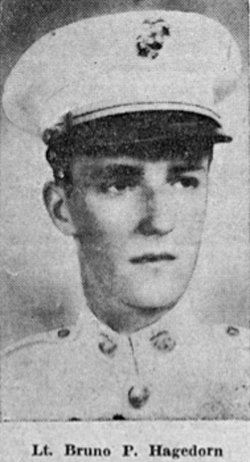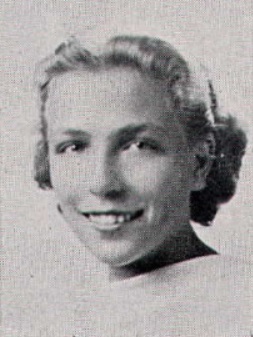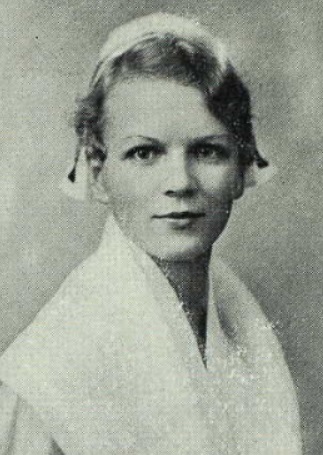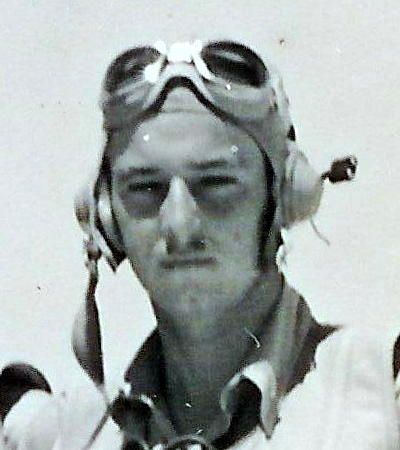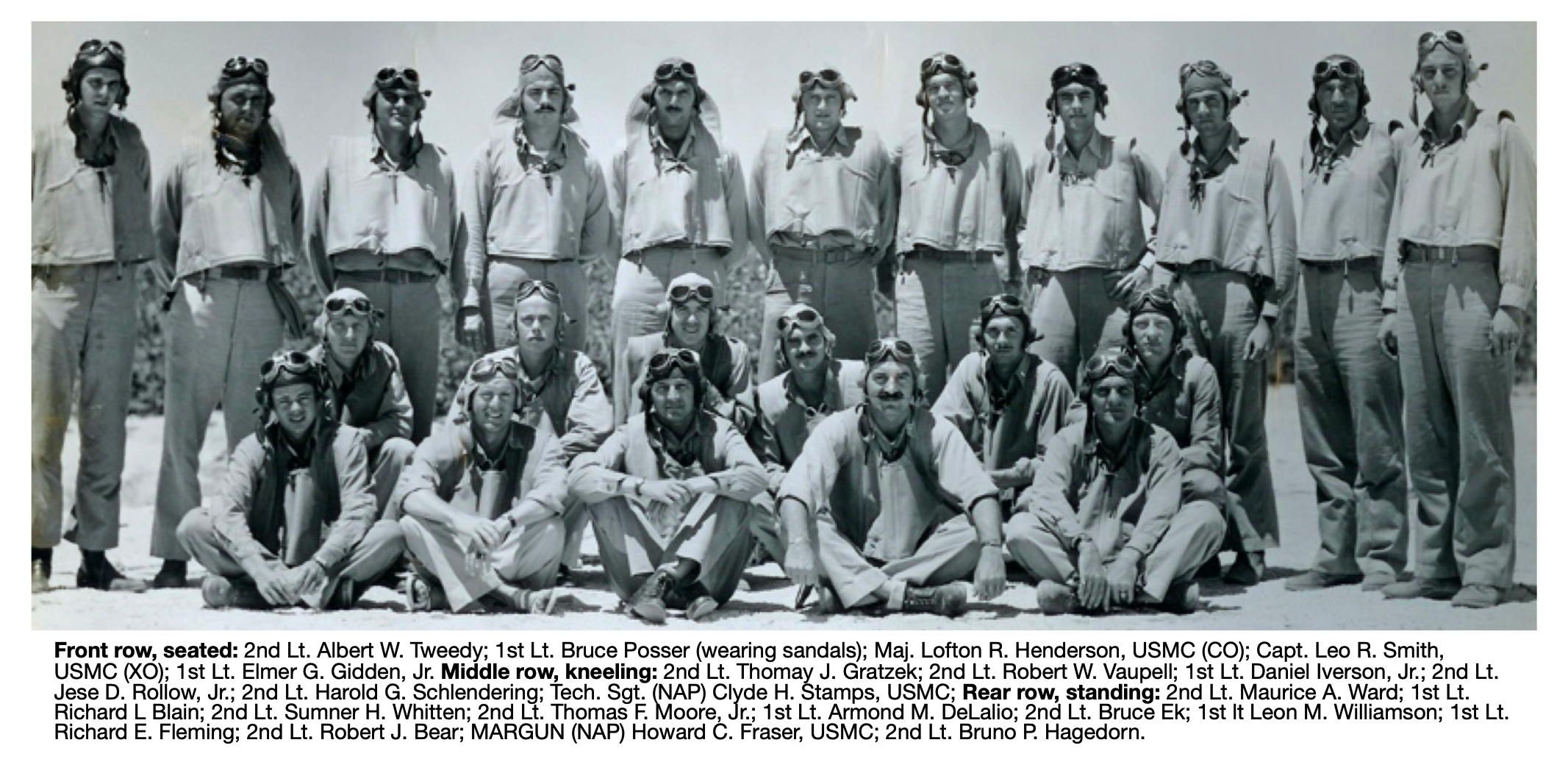In 1936 while he was still in college, Bruno joined the Marine Corps Reserve in Newark with the rank of Private. He attended weekly drills with Company D, Fourth Battalion until October 20, 1937, when his unit was absorbed into the Limited Service Unit of the 3rd Reserve District based in Brooklyn, New York. In 1940 Bruno re-enlisted in the active Marine Corps and applied to become a Marine Corps aviator. His application was accepted and he was sent to Squantum, Massachusetts, for his elimination training. Bruno successfully passed this phase of his career and moved on to Naval Air Field at Pensacola, Florida, as a Student Naval Aviation Pilot. Again, Bruno completed his training and was awarded his gold Navy Pilot's wings and commissioned as a Second Lieutenant of Marines. From Florida Bruno was ordered to California. While there Becky traveled to met him and they married.
Bruno's time with Becky was short as he soon received orders to ship out. He did not know it at the time, but he was on his way to combat in the Pacific at a place called Midway Island.
On April 17, 1942, Bruno disembarked from the USS WILLIAM WARD BURROWS and reported to the commander of VMSB-241 on Midway Island, under the command of the new commanding officer, who had came to Midway with Bruno, Major Lofton Henderson.
Private First Class Joseph Piraneo was assigned to be Bruno's gunner and together they started out flying an obsolete cloth covered Vought SB2U Vindicator dive-bomber. On May 26th, the squadron received a few Douglas Dauntless SBD-2 dive-bombers. Bruno and PFC Piraneo were fortunate to be chosen to fly one of the new planes, #2139, although they would have only a few days to learn to operate it. They were assigned as wingmen to Lt. Albert Tweedy and Sgt. Elza Raymond; together, their two planes comprised the Fourth Section of the squadron's First Division.
On the morning of June 4, 1942, Maj. Henderson led his men into their first, and for most, last, combat action against the Empire of Japan. Bruno and PFC Piraneo took off from Midway and, as Japanese planes turned the Marine base into rubble behind them, flew off to try and find the carrier strike force that was approaching their territory.
After nearly ninety minutes in the air, the Americans spotted the carriers – and were in turn spotted by patrolling Japanese planes from the carrier HIRYU. The slow dive bombers, unable to dive properly due to the pilots inexperience with their new planes, were easy targets. Soon, seven of the bombers were falling in flames – one of them carried Bruno and PFC Piraneo to their deaths, though none of the survivors of that day actually remember seeing what happened to them.
Bruno was awarded a posthumous Navy Cross for his actions in the battle. His citation reads as follows:
"The President of the United States takes pride in presenting the Navy Cross (Posthumously) to Bruno P. Hagedorn (0-7480), Second Lieutenant, U.S. Marine Corps (Reserve), for extraordinary heroism and distinguished service in the line of his profession while serving as a Pilot in Marine Scout-Bombing Squadron TWO HUNDRED FORTY-ONE (VMSB-241), Marine Air Group TWENTY-TWO (MAG-22), Naval Air Station, Midway, during operations of the U.S. Naval and Marine Forces against the invading Japanese Fleet during the Battle of Midway on 4 June 1942. During the initial attack upon an enemy aircraft carrier, Second Lieutenant Hagedorn, in the face of withering fire from Japanese fighter guns and anti-aircraft batteries, dived his plane to a perilously low altitude before releasing his bombs. Since he failed to return to his base and is mission in action, there can be no doubt, under conditions attendant to the Battle of Midway, that he gave up his life in the defense of his country. His cool courage and conscientious devotion to duty were in keeping with the highest traditions of the United States Naval Service.
To this day, what actually happened to Bruno and his gunner is unknown. But there is no doubt that their plane lies at the bottom of the Pacific where Bruno still sits at his planes controls. Semper Fidelis...Always Faithful.
At the time of his death, Bruno's wife was living at 1439 Munn Avenue, Hillside, Elizabeth, New Jersey. They had been married less than 4 months.
Second Lieutenant Bruno Paul Hagedorn, Sn# O-007480, earned the following badges/decorations for his service in the United States Marine Corps during World War II:
- Navy Gold Pilot's Wings
- Navy Cross Medal
- Purple Heart Medal
- Combat Action Ribbon
- Presidential Unit Citation Ribbon
- American Defense Service Medal
- Asiatic-Pacific Theater of Operations Campaign Medal with one bronze battle/campaign star
- World War II Victory Medal
**NOTE** - A portion of this bio is based on information from the website missingmarines.com. They have done a fantastic job of researching approximately 3000 US Marines whose bodies were lost in the war. This writer wholeheartedly recommends their site for researchers or families of the missing. - Rick Lawrence, MSgt., USMC/USAFR {RET})
In 1936 while he was still in college, Bruno joined the Marine Corps Reserve in Newark with the rank of Private. He attended weekly drills with Company D, Fourth Battalion until October 20, 1937, when his unit was absorbed into the Limited Service Unit of the 3rd Reserve District based in Brooklyn, New York. In 1940 Bruno re-enlisted in the active Marine Corps and applied to become a Marine Corps aviator. His application was accepted and he was sent to Squantum, Massachusetts, for his elimination training. Bruno successfully passed this phase of his career and moved on to Naval Air Field at Pensacola, Florida, as a Student Naval Aviation Pilot. Again, Bruno completed his training and was awarded his gold Navy Pilot's wings and commissioned as a Second Lieutenant of Marines. From Florida Bruno was ordered to California. While there Becky traveled to met him and they married.
Bruno's time with Becky was short as he soon received orders to ship out. He did not know it at the time, but he was on his way to combat in the Pacific at a place called Midway Island.
On April 17, 1942, Bruno disembarked from the USS WILLIAM WARD BURROWS and reported to the commander of VMSB-241 on Midway Island, under the command of the new commanding officer, who had came to Midway with Bruno, Major Lofton Henderson.
Private First Class Joseph Piraneo was assigned to be Bruno's gunner and together they started out flying an obsolete cloth covered Vought SB2U Vindicator dive-bomber. On May 26th, the squadron received a few Douglas Dauntless SBD-2 dive-bombers. Bruno and PFC Piraneo were fortunate to be chosen to fly one of the new planes, #2139, although they would have only a few days to learn to operate it. They were assigned as wingmen to Lt. Albert Tweedy and Sgt. Elza Raymond; together, their two planes comprised the Fourth Section of the squadron's First Division.
On the morning of June 4, 1942, Maj. Henderson led his men into their first, and for most, last, combat action against the Empire of Japan. Bruno and PFC Piraneo took off from Midway and, as Japanese planes turned the Marine base into rubble behind them, flew off to try and find the carrier strike force that was approaching their territory.
After nearly ninety minutes in the air, the Americans spotted the carriers – and were in turn spotted by patrolling Japanese planes from the carrier HIRYU. The slow dive bombers, unable to dive properly due to the pilots inexperience with their new planes, were easy targets. Soon, seven of the bombers were falling in flames – one of them carried Bruno and PFC Piraneo to their deaths, though none of the survivors of that day actually remember seeing what happened to them.
Bruno was awarded a posthumous Navy Cross for his actions in the battle. His citation reads as follows:
"The President of the United States takes pride in presenting the Navy Cross (Posthumously) to Bruno P. Hagedorn (0-7480), Second Lieutenant, U.S. Marine Corps (Reserve), for extraordinary heroism and distinguished service in the line of his profession while serving as a Pilot in Marine Scout-Bombing Squadron TWO HUNDRED FORTY-ONE (VMSB-241), Marine Air Group TWENTY-TWO (MAG-22), Naval Air Station, Midway, during operations of the U.S. Naval and Marine Forces against the invading Japanese Fleet during the Battle of Midway on 4 June 1942. During the initial attack upon an enemy aircraft carrier, Second Lieutenant Hagedorn, in the face of withering fire from Japanese fighter guns and anti-aircraft batteries, dived his plane to a perilously low altitude before releasing his bombs. Since he failed to return to his base and is mission in action, there can be no doubt, under conditions attendant to the Battle of Midway, that he gave up his life in the defense of his country. His cool courage and conscientious devotion to duty were in keeping with the highest traditions of the United States Naval Service.
To this day, what actually happened to Bruno and his gunner is unknown. But there is no doubt that their plane lies at the bottom of the Pacific where Bruno still sits at his planes controls. Semper Fidelis...Always Faithful.
At the time of his death, Bruno's wife was living at 1439 Munn Avenue, Hillside, Elizabeth, New Jersey. They had been married less than 4 months.
Second Lieutenant Bruno Paul Hagedorn, Sn# O-007480, earned the following badges/decorations for his service in the United States Marine Corps during World War II:
- Navy Gold Pilot's Wings
- Navy Cross Medal
- Purple Heart Medal
- Combat Action Ribbon
- Presidential Unit Citation Ribbon
- American Defense Service Medal
- Asiatic-Pacific Theater of Operations Campaign Medal with one bronze battle/campaign star
- World War II Victory Medal
**NOTE** - A portion of this bio is based on information from the website missingmarines.com. They have done a fantastic job of researching approximately 3000 US Marines whose bodies were lost in the war. This writer wholeheartedly recommends their site for researchers or families of the missing. - Rick Lawrence, MSgt., USMC/USAFR {RET})
Gravesite Details
Entered the service from New Jersey.
